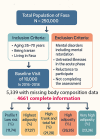Latent profiles of body composition indices and their associations with cardiovascular diseases, hypertension, and diabetes: results from the Fasa Adult Cohort study (FACS)
- PMID: 40611312
- PMCID: PMC12224720
- DOI: 10.1186/s41043-025-00980-6
Latent profiles of body composition indices and their associations with cardiovascular diseases, hypertension, and diabetes: results from the Fasa Adult Cohort study (FACS)
Abstract
Background: The body mass index (BMI) is a common obesity indicator; however, it has limitations in distinguishing between muscle and fat and does not consider fat distribution. This study examines the association between the latent profile of body composition indices and cardiovascular diseases, hypertension, and diabetes.
Method: This cross-sectional study utilized baseline data from the Fasa Adult Cohort Study (FACS), which included 4,661 participants aged 35 to 70 years. Body composition indices were assessed using bioelectrical impedance analysis (BIA). Latent profile analysis (LPA) was conducted to identify distinct body composition profiles, and the associations between these profiles and the presence of cardiovascular diseases, hypertension, and diabetes were evaluated using multivariable logistic regression models.
Results: Among diabetes patients, 151 (26.44%) were male. Additionally, 1,218 (93.26%) of smokers were male. There were significant associations between gender and the prevalence of hypertension, diabetes, metabolic syndrome, and cardiovascular disease. The LPA identified five distinct latent profiles, with profiles characterized by higher body fat percentages demonstrating increased odds of diabetes (OR: 5.64, %95CI: 2.86 -to 11.11) and cardiovascular diseases (OR: 2.19, %95CI: 1.11 to 4.31) compared to a low-risk group. Additionally, profiles with higher body fat metrics were associated with significantly increased odds of hypertension (OR: 8.75, 95% CI: 4.60 to 16.65).
Conclusion: The findings emphasize the complex interplay between body composition and the Odds of NCDs, highlighting the importance of detailed body composition assessments in public health initiatives. Understanding these relationships can inform targeted prevention and management strategies for NCDs.
Keywords: Body composition; Cardiovascular diseases; Diabetes; Hypertension; Latent profile analysis.
© 2025. The Author(s).
Conflict of interest statement
Declarations. Ethics approval and consent to participate: The authors adhered to ethical standards concerning plagiarism, informed consent, misconduct, data fabrication and/or falsification, double publication and/or submission, redundancy, and related issues. This study was conducted under the ethical guidelines outlined in the Declaration of Helsinki and the Strengthening the Reporting of Observational Studies in Epidemiology (STROBE) guidelines. The study was approved by the Research Ethics Committee of Fasa University of Medical Sciences (IR.FUMS.REC.1402.069). The Research Ethics Committee waived informed consent. Consent for publication: Not applicable. Competing interests: The authors declare no competing interests. Conflict of interest: The authors declare no conflicts of interest. Clinical trial number: Not applicable.
Figures


References
-
- WHO GS. Global status report on noncommunicable diseases 2010. 2014.
-
- Eghtesad S, Mohammadi Z, Shayanrad A, Faramarzi E, Joukar F, Hamzeh B, et al. The PERSIAN cohort: providing the evidence needed for healthcare reform. Arch Iran Med. 2017;20(11):691–5. - PubMed
MeSH terms
LinkOut - more resources
Full Text Sources
Medical
Miscellaneous

